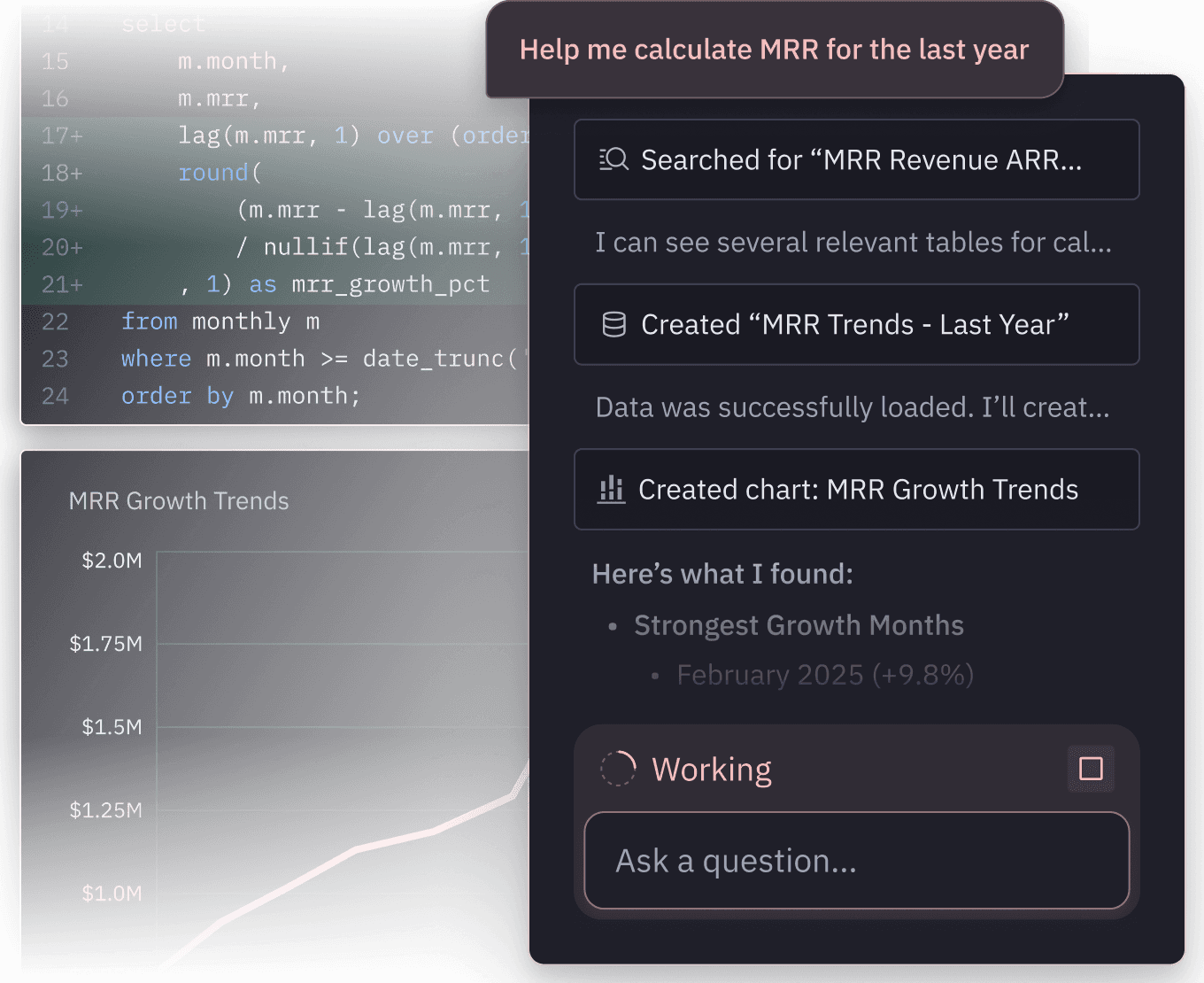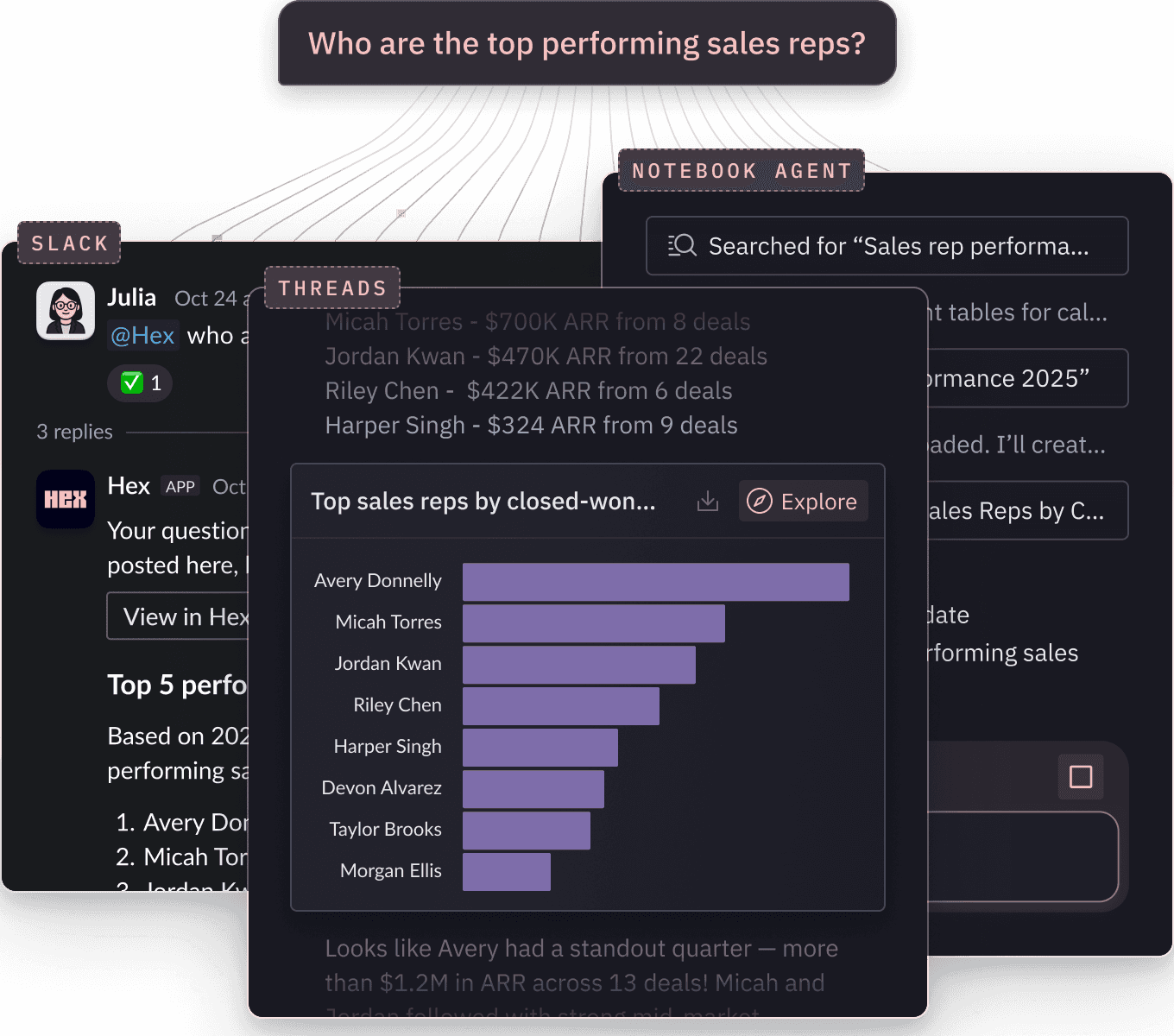Comparing Hex vs. Sigma
Choosing between Hex and Sigma? Modern data teams choose Hex to power faster, deeper insights with AI.
Trusted by leading data companies
"Our vision for Notion’s data team is that anyone, regardless of technical proficiency, is comfortable using data to answer their own questions – and Hex enables that."
Abhishek Modi, Software Engineer"We like to embed Hex dashboards where teams work."
Ian Macomber, Head of Data and Analytics Engineering"We’re regarded as top performers because the work we are doing is deemed more credible and more widely surfaced than before Hex."
Kate Urquiola, Director, Go-to-Market Analytics"Hex has helped us empower business analysts to explore and dig into data on their own"
Meghana Reddy, Head of Data at Stubhub
Why companies choose Hex over Sigma
A toolkit for data teams to explore any question
Hex gives data teams everything they need to answer any question—from quick lookups to deep analysis. Agentic notebooks blend SQL, Python, no-code, and visualization with AI for fast, reproducible results.
Sigma works for basic metric slicing and simple queries, but data teams hit a wall when questions go deeper.

Comparison breakdown
Features
Hex
Sigma
SQL + Python exploration
Code-first analysis with seamless language switching
Hex
Notebooks let you mix SQL, Python, and no-code cells interchangeably; a reactive graph engine keeps analyses clear, connected, and reproducible.
Sigma
Python runs only on a limited set of supported warehouse runtimes, with no unified execution model between SQL and Python for seamless workflows.
Visualizations
Charts and plots to explore and share insights
Hex
Native charts and Python libraries (Plotly, Matplotlib, Altair) in one place.
Sigma
Native charts with plugin support for custom visuals.
Agentic analytics
AI agent for helping data teams query, analyze, and visualize data
Hex
Built-in AI agents assist directly in the notebook—writing and editing SQL, Python, charts, and multi-step analyses.
Sigma
No built-in AI assistance for code or analysis creation.
Agentic modeling
AI-assisted modeling for curated, reusable metrics
Hex
AI modeling agent helps build and edit semantic models that can be used across notebooks, apps, and Threads.
Sigma
Modeling must be authored manually; no AI support for creation or editing.
Business users self-serve in plain language
Sigma constrains business users to clicking through spreadsheets or one-shot AI interfaces. It’s fine for showing what happened, but rarely answers why or what’s next.
With Hex, stakeholders use Threads to ask questions in plain language and get rich answers they can refine through follow-ups.

Comparison breakdown
Features
Hex
Sigma
Conversational AI
Converse in natural language, get instant insights
Hex
Threads supports true back-and-forth Q&A with live data; context persists and any Thread can open as a notebook for deeper analysis/inspection.
Sigma
Ask Sigma handles single-turn natural language questions but doesn’t maintain conversational context or multi-step follow ups.
No code exploration
Spreadsheet-style analysis with pivots and drag-and-drop
Hex
Combine spreadsheets, pivots, and visualizations in drag & drop explorations.
Sigma
Spreadsheet-like Workbooks for slicing, filtering, and pivoting data tables without SQL.
Interactive data apps
Outputs accessible and explorable by every user type
Hex
First-class data apps with inputs, pages, and controls, driven by live projects.
Sigma
App-like Workbooks with parameters and actions.
Connected workflows unlock collaboration and context
In Hex, every workflow stays connected. Whether analyzing in Notebooks, exploring in Threads, or interacting with Apps—data teams and business users all work from the same project. Updates flow automatically, keeping everyone in sync.
In Sigma, follow-ups mean switching tools or rebuilding logic, siloing context and slowing down analysis.

Comparison breakdown
Features
Hex
Sigma
Real-time collaboration
Live sharing and iteration across code, queries, and results
Hex
True multiplayer editing in notebooks and apps, with built-in comments and snapshots that keep feedback in context.
Sigma
Teams can edit and comment together in Workbooks, mainly when building or reviewing dashboards.
Connected workflows
Stay in one context across modes of work
Hex
All parts of Hex--Notebooks, Threads, and Apps--run from the same live project, so teams can collaborate back and forth on the same shared context.
Sigma
Workbooks, dashboards, and Ask Sigma are connected by lineage but run separately. Each re-runs its own query, so context doesn't persist between them.
Compounding context
AI that gets smarter with every project
Hex
Every project in Hex can be referenced by AI, so future analyses gain more context over time. Threads and the Notebook Agent build on past work to improve suggestions and reasoning.
Sigma
No shared AI memory or project context; each chat or query starts from scratch without awareness of prior analyses.
Unify the full cycle of data work with Hex.
Leave disconnected workflows behind.
Hear from data teams that chose Hex
Learn how the best companies in the world increase team efficiency using Hex.
FAQ
Can't find your answer here? Get in touch.




